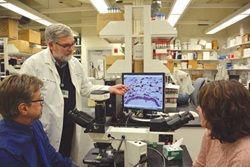Michigan State Researchers Discover a Roadblock to Autoimmunity
INSIDE ACADEMIA
 Every chemical substance, whether natural or manmade, can be toxic if it is ingested, inhaled, or absorbed at levels that cause toxicity. This is true of micronutrients that are essential to the human body; compounds that occur naturally in animals, plants, and soil; chemicals that humans make and use in a variety of products; and even water. For this reason, the longstanding tenet of toxicology is “the dose makes the poison.” But in many cases, the dose of a substance can be beneficial or curative—or perhaps open the doorway to a cure for a set of disorders affecting more than 50 million Americans: autoimmunity. Food and toxicology researchers at Michigan State University (MSU) have determined that, by blocking a known trigger of autoimmunity, a natural dietary component of certain foods can delay or prevent onset of one of the most prevalent autoimmune diseases.
Every chemical substance, whether natural or manmade, can be toxic if it is ingested, inhaled, or absorbed at levels that cause toxicity. This is true of micronutrients that are essential to the human body; compounds that occur naturally in animals, plants, and soil; chemicals that humans make and use in a variety of products; and even water. For this reason, the longstanding tenet of toxicology is “the dose makes the poison.” But in many cases, the dose of a substance can be beneficial or curative—or perhaps open the doorway to a cure for a set of disorders affecting more than 50 million Americans: autoimmunity. Food and toxicology researchers at Michigan State University (MSU) have determined that, by blocking a known trigger of autoimmunity, a natural dietary component of certain foods can delay or prevent onset of one of the most prevalent autoimmune diseases.
Defining Autoimmunity
The human immune system consists of a network of tissues and cells that work collaboratively to identify, kill, and eliminate invaders such as viruses, bacteria, or unfamiliar proteins. In some people, however, the immune system repeatedly attacks healthy cells and tissues that are normally present in the body, mistaking them for invaders. This reaction is called autoimmunity, and the disorder is manifested in more than 80 different autoimmune diseases, including type 1 diabetes, rheumatoid arthritis, multiple sclerosis, psoriasis, and systemic lupus erythematosus. Scientists are not sure what causes autoimmune diseases but suspect that a combination of factors both inside and outside the body may be involved. Thus, genes may predispose individuals to autoimmunity, but environmental factors may trigger it.
 At MSU, research on blocking the triggers of autoimmunity began with James Pestka, a professor in the department of food science and human nutrition. Pestka had been studying immunochemical reactions and the immunotoxic effects of fungal toxins when he became interested in toxin-induced autoimmunity. “We received a [National Institutes of Health] grant in 1984 to look at the potential immunotoxic effects of [vomitoxin (also called deoxynivalenol)]. There had been a lot of anecdotal reports in literature that toxins of this class—the trichothecenes—were immunosuppressive. So we started to look at how this toxin could potentially affect immune function in a mouse model,” Pestka says. “We were surprised to find that the toxin was not immunosuppressive but was immuno-stimulatory and could actually stimulate an inflammatory response and also an autoimmune response in the mice.” In particular, vomitoxin induced an autoimmune disease called IgA nephropathy, a common glomerulonephritis in humans. “And that’s how we started to get interested in toxin-induced autoimmunity,” Pestka says.
At MSU, research on blocking the triggers of autoimmunity began with James Pestka, a professor in the department of food science and human nutrition. Pestka had been studying immunochemical reactions and the immunotoxic effects of fungal toxins when he became interested in toxin-induced autoimmunity. “We received a [National Institutes of Health] grant in 1984 to look at the potential immunotoxic effects of [vomitoxin (also called deoxynivalenol)]. There had been a lot of anecdotal reports in literature that toxins of this class—the trichothecenes—were immunosuppressive. So we started to look at how this toxin could potentially affect immune function in a mouse model,” Pestka says. “We were surprised to find that the toxin was not immunosuppressive but was immuno-stimulatory and could actually stimulate an inflammatory response and also an autoimmune response in the mice.” In particular, vomitoxin induced an autoimmune disease called IgA nephropathy, a common glomerulonephritis in humans. “And that’s how we started to get interested in toxin-induced autoimmunity,” Pestka says.
Pestka and his research team received continuous funding from the National Institutes of Health to understand how and why vomitoxin caused autoimmunity. “One outgrowth of that research was looking at ways of intervening in that disease,” Pestka says, so he and his colleagues fed fish oils containing omega-3 fatty acids to mice with toxin-induced IgA nephropathy and observed that the omega-3s were beneficial in suppressing the disease. He and his colleagues went on to study the mechanisms through which that suppression occurs for several years. Then in 2008, Pestka joined forces with other researchers at MSU to determine whether omega-3 fatty acids would have any effect on another autoimmune disease: systemic lupus erythematosus.
Lupus is a chronic autoimmune disease that can affect the skin, joints, kidneys, heart, nerves, blood vessels, and more. As with other autoimmune diseases, no one is sure what causes lupus, but many scientists believe that lupus develops in response to a combination of factors, including genetics, hormones, and environmental factors. Interestingly, no specific gene or group of genes has been proven to cause lupus. It is therefore believed that genes alone are not enough to cause lupus, but certain genes have been deemed contributors to the development of the disease. “There’s no one gene that drives lupus; there are probably multiple genes and they overlap. So if you have a family member that has lupus, your chances of getting lupus are one in 25,” Pestka says. “But the intriguing issue is that when an identical twin develops lupus, only in about 25% of cases or less does the other twin develop lupus. That suggests that there are environmental factors that could promote the development of lupus in humans.”
DHA and Lupus
 Despite the revelation that environmental factors may be involved in the development of lupus, “most of the research has emphasized the genetics,” Pestka says. “We went to an autoimmunity meeting two years ago, and the immunologists and people working on autoimmunity had focused all of their work on how genetics impacted the immune system and very little research on the environment. We call it the exposome—the lifelong habits of what people eat and what they’re exposed to in the environment.” Pestka has been working with Jack Harkema, a professor in the department of pathobiology and diagnostic investigation, and Melissa Bates, a doctoral student in the department of food science and human nutrition, to investigate how environmental factors impact lupus and other autoimmune diseases. “Our recent work has focused on how two factors—diet and exposure to an environmental toxicant—could attenuate or potentiate the disease,” Pestka says. Exposure to crystalline silica, the most common mineral in the world, has been linked to the onset of lupus and other autoimmune diseases, and diet may influence an individual’s susceptibility to autoimmunity. More specifically, dietary intake of the omega-3 fatty acid docosahexaenoic acid (DHA) seems to have a profound effect on lupus.
Despite the revelation that environmental factors may be involved in the development of lupus, “most of the research has emphasized the genetics,” Pestka says. “We went to an autoimmunity meeting two years ago, and the immunologists and people working on autoimmunity had focused all of their work on how genetics impacted the immune system and very little research on the environment. We call it the exposome—the lifelong habits of what people eat and what they’re exposed to in the environment.” Pestka has been working with Jack Harkema, a professor in the department of pathobiology and diagnostic investigation, and Melissa Bates, a doctoral student in the department of food science and human nutrition, to investigate how environmental factors impact lupus and other autoimmune diseases. “Our recent work has focused on how two factors—diet and exposure to an environmental toxicant—could attenuate or potentiate the disease,” Pestka says. Exposure to crystalline silica, the most common mineral in the world, has been linked to the onset of lupus and other autoimmune diseases, and diet may influence an individual’s susceptibility to autoimmunity. More specifically, dietary intake of the omega-3 fatty acid docosahexaenoic acid (DHA) seems to have a profound effect on lupus.
 For their research on DHA and lupus, Pestka, Harkema, and Bates used a type of mice that spontaneously develops lupus at about nine months of age and exposed them to silica dust. “We found that in our lupus model, we could induce the onset of lupus three months early by airway exposure to this mineral. Normally the mice in this lupus model develop it at about 34 or 36 weeks. After silica exposure, we were able to see it develop at 22 or 24 weeks—three months earlier,” Pestka says. Harkema reviewed the pathogenesis of the animals’ inhalation of silica dust and observed that the mice experienced lesions in their kidneys as well as their lungs. “It’s always been thought that the first place you look for the effects of inhaled pollutants—whether it be air pollutants or cigarette smoke or silica dust—would be the respiratory tract. That’s kind of the target. But now we know, especially from work with cigarette smoke, that [inhaled pollutants] affect the whole body,” Harkema says.
For their research on DHA and lupus, Pestka, Harkema, and Bates used a type of mice that spontaneously develops lupus at about nine months of age and exposed them to silica dust. “We found that in our lupus model, we could induce the onset of lupus three months early by airway exposure to this mineral. Normally the mice in this lupus model develop it at about 34 or 36 weeks. After silica exposure, we were able to see it develop at 22 or 24 weeks—three months earlier,” Pestka says. Harkema reviewed the pathogenesis of the animals’ inhalation of silica dust and observed that the mice experienced lesions in their kidneys as well as their lungs. “It’s always been thought that the first place you look for the effects of inhaled pollutants—whether it be air pollutants or cigarette smoke or silica dust—would be the respiratory tract. That’s kind of the target. But now we know, especially from work with cigarette smoke, that [inhaled pollutants] affect the whole body,” Harkema says.
The lesions were most dramatic in the lungs, where the researchers noticed something else. “We found that silica causes the lung to actually become like an immune organ like the spleen or a lymph lode. So it starts to actually develop what we call tertiary lymphoid tissue, which is a lymph node in a place it’s not supposed to be,” Pestka reveals. “We were probably one of the first to really recognize the lung lesions that are caused by the combination of lupus and silica. Once we found that, these were biomarkers that we could assess whether or not the DHA was working,” Harkema adds. “One way we thought of to alleviate the health effects was to [use] some type of diet compound—this was really Dr. Pestka’s interest and expertise—that protects the whole body, including the respiratory tract.” The researchers then began feeding the mice a microalgal compound containing solely DHA prior to exposing them to silica. “This study was to look at preventing the lesions. The idea there was that people know that they have lupus, there are certain things that can trigger it, and one of them is inhaling silica,” Harkema says.
Previous studies had established that omega-3 fatty acids extended the life span of mice with lupus, but the mice in those studies by other laboratories were fed fish oil, which contains DHA and eicosapentaenoic acid (EPA). “There’ve been studies done by other laboratories that have compared the other omega-3 fatty acids—EPA, DHA, and [alpha linolenic acid]—in their own right. What those studies found was that [omega-3 fatty acids] were effective at extending the lifespan of these mice that developed lupus. With information from [previous research] and studies done by our own laboratory, we narrowed it down to DHA,” Bates says. “When the animals were put on a diet of [DHA], … the silica-induced lesions in these animals were almost completely alleviated. I’ve never seen anything so dramatic before: over 90% of the lesions, the pulmonary injury, was gone,” Harkema declares.
DHA has proven to be effective not only in preventing the onset of lupus but also in suppressing the symptoms of lupus. In addition, while autoimmune drugs usually focus on one molecular target, Pestka, Harkema, and Bates have noticed that DHA seems to suppress many of them. This means that suppression of different molecular factors with omega-3 fatty acids (both DHA and EPA) can occur for a fraction of the cost of multiple drugs needed to do the same thing. This is likely due to the anti-inflammatory properties of omega-3 fatty acids. “Omega-3 fatty acids actually have metabolites that … actually resolve inflammation,” Pestka points out. “These anti-inflammatory mediators are actually very, very potent. …We’re going to be looking at production of these mediators, and there could be thousands of these anti-inflammatory mediators.” Bates provides additional detail: “Part of our longer term research would be to maintain these mice on [DHA] and determine how long we can prevent the onset of lupus,” she says.
Future Research
Because their research has elicited such remarkable outcomes, human clinical trials seem to be the logical next step. The execution of such trials, however, would not be so straightforward. “It would be difficult, and the reason it’s difficult is that you have to work with a population that is susceptible to lupus, … and it could be a really lengthy study—20 or 30 years,” Pestka says. Potential clinical populations are clear: Women ages 15–44 are nine times more susceptible to lupus than men are, and women of color (black, Asian, Hispanic, and Native American) have even greater susceptibility, but diagnosing lupus is difficult and elusive and continuing a trial for 10 or more years is expensive. There is no standard test for diagnosis and the symptoms of lupus are similar to those of other illnesses. Even without clinical trials, Pestka and Harkema are confident that their findings can benefit humans. “I’ve done a lot of toxicology studies, and some translate to human conditions and some wouldn’t be appropriate,” Harkema says. “The results were so dramatic in this one that I think that people who are looking into clinical trials will pick up on this.” Pestka concurs: “You know, if I had early signs of lupus, such as autoantibodies, I’d take a DHA supplement because it’s safe. [Drugs that treat lupus], like prednisone, [are] really, really damaging to the other tissues in the body.”
www.ift.org
Online Exclusive: Reducing the Risk of Mycotoxins
Read about Michigan State University professor Felicia Wu’s research on mycotoxins and how bioengineered crops can reduce the prevalence of mycotoxins at ift.org/food-technology/current-issue.aspx.
Toni Tarver is senior writer/editor of Food Technology magazine ([email protected]).

 Silica-induced lupus research emphasizes Michigan State University (MSU) professor James Pestka’s expertise in immunology, but he is also an expert in food toxicology. “Food toxicology is the study of how chemicals in food can cause illness. A better term might be ‘food safety assessment’ because, basically, the dose makes the poison. So you could have very trace levels of a toxic chemical in a food, and it’s not going to affect you. You have the capability of clearing that chemical from your body through metabolism,” Pestka says. “And then a chemical could be in food in a large amount, and it could have toxic effects. Food toxicologists look at that dose response and try to predict what would be the risk associated with that foodborne chemical.”
Silica-induced lupus research emphasizes Michigan State University (MSU) professor James Pestka’s expertise in immunology, but he is also an expert in food toxicology. “Food toxicology is the study of how chemicals in food can cause illness. A better term might be ‘food safety assessment’ because, basically, the dose makes the poison. So you could have very trace levels of a toxic chemical in a food, and it’s not going to affect you. You have the capability of clearing that chemical from your body through metabolism,” Pestka says. “And then a chemical could be in food in a large amount, and it could have toxic effects. Food toxicologists look at that dose response and try to predict what would be the risk associated with that foodborne chemical.” Both professors are affiliated with the Institute of Integrative Toxicology (IIT), which is a multidisciplinary academic unit at MSU that conducts research on foodborne, environmental, occupational, and pharmaceutical agents. IIT was founded in response to the mishandling of the polybrominated biphenyls (PBBs) crisis in Michigan in the 1970s. The crisis occurred after bags of flame retardant containing PBBs were accidentally mixed with animal feed and distributed to farms in Michigan. Chickens, beef and dairy cattle, pigs, and sheep that consumed the feed became ill and died, and some Michiganders who ate the affected animals and their products suffered health problems that may be linked to PBB ingestion. In the United States, instances of acute toxicity such as Michigan’s PBB crisis “are very rare,” Pestka says. “The prime concern is if you’re eating a chemical or contaminant at low doses for an extended period or if a mother is eating it prior to conceiving a child. Developmental toxicology is an important issue: the ability of these chemicals to cause epigenetic effects or affect the children born of pregnant mothers who are exposed to a [toxic] chemical. Those are…big challenge[s] for food toxicologists.” The long-term effects of Michigan’s PBB crisis are still not known and are the focus of ongoing studies.
Both professors are affiliated with the Institute of Integrative Toxicology (IIT), which is a multidisciplinary academic unit at MSU that conducts research on foodborne, environmental, occupational, and pharmaceutical agents. IIT was founded in response to the mishandling of the polybrominated biphenyls (PBBs) crisis in Michigan in the 1970s. The crisis occurred after bags of flame retardant containing PBBs were accidentally mixed with animal feed and distributed to farms in Michigan. Chickens, beef and dairy cattle, pigs, and sheep that consumed the feed became ill and died, and some Michiganders who ate the affected animals and their products suffered health problems that may be linked to PBB ingestion. In the United States, instances of acute toxicity such as Michigan’s PBB crisis “are very rare,” Pestka says. “The prime concern is if you’re eating a chemical or contaminant at low doses for an extended period or if a mother is eating it prior to conceiving a child. Developmental toxicology is an important issue: the ability of these chemicals to cause epigenetic effects or affect the children born of pregnant mothers who are exposed to a [toxic] chemical. Those are…big challenge[s] for food toxicologists.” The long-term effects of Michigan’s PBB crisis are still not known and are the focus of ongoing studies.